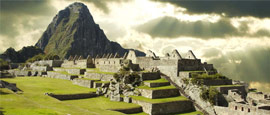Cusco History
At more than 3,000 years old, Cusco is one of the oldest cities in South America. As the Inca civilisation developed in the 13th century, it became the centre of an Empire, which in the 15th and 16th centuries would expand to include much of western South America.
Inca builders originally laid out the city in the form of a puma: the fortress of Sacsayhuaman, which pre-dates the Incas, was the head; the plaza of Huacaypata the belly, and the Huatanay and Tullumayo rivers acted as the tail. Its ancient plaza was the core of the Four Regions of the Inca Empire, which stretched from Quito in Ecuador to northern Chile. That was until the Spanish arrived under Francisco Pizarro in 1533.
Today, most tourists use Cusco as a base for seeking out the extraordinary ruins of Machu Picchu. But the Inca structures that once stood in the heart of modern-day Cusco would have been easily as impressive. Pizarro himself wrote to King Charles V to say the city would look “remarkable even in Spain”, before laying waste to it. Many of the grand colonial churches and houses built in their place used the foundations of the Inca buildings, and their remnants in Cusco are impossible to ignore.
After stripping Cusco of its riches, the Spanish focussed on Lima as the capital of Peru in 1535. But in 1780, the forgotten city witnessed one of the most important revolts against colonial rule in the Americas. Tupac Amaru II’s uprising of native and meztiso peasants was defeated by the Spanish in Cusco and he was killed after being forced to watch the execution of his family. This was a vital precursor to 1821’s declaration of independence from Spain.
It wasn’t until 1911, when explorer Hiram Bingham rediscovered Machu Pichu (guided by local farmer Melchor Arteaga), that Cusco finally returned as one of the greatest cities in South America. The income from tourism has seen it develop rapidly in recent decades, with the city’s baroque architecture and Inca history making it a remarkable destination in its own right.
Did you know?
• The Incas were able to take fresh fish from Chala (near Arequipa) to Machu Picchu within 24 hours, thanks to relay messengers known as chaski. These couriers would sprint along the Inca trails between refreshment stations known as tambos. Upon reaching a station, they would then pass on the fish, and the process was repeated until they reached Machu Picchu.
• Although Hiram Bingham told the wider world about Machu Pichu, it’s thought that it had previously been ‘discovered’ by Thomas Payne, a British missionary.
• Once a year, during the June solstice, the sun is at the right angle to shine a beam of light through a window of the Sun Temple at Machu Picchu. Some believe it used to shine upon a statue of Pachacutec that has long been removed.
Do you have any Feedback about this page?
© 2025 Columbus Travel Media Ltd. All rights reserved. No part of this site may be reproduced without our written permission, click here for information on Columbus Content Solutions.




 You know where
You know where